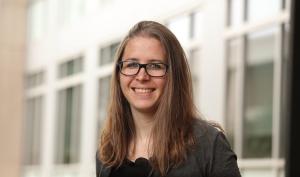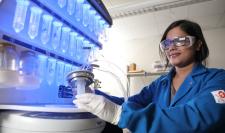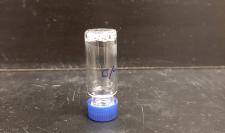
Rachel Letteri digs polymers because, in them, she sees so many possibilities.
“Just like the proteins in our body, which are made up of 20 amino acid building blocks strung together in a precise way that gives them so many important roles, polymers are big molecules that string together many different building blocks and play so many important roles in medicine and engineering,” said Letteri, an assistant professor of chemical engineering at the University of Virginia School of Engineering and Applied Science.
This compiling of single-molecule building blocks into macromolecules designed to do a job – either by nature or by people – is ubiquitous. Polymers are in everything from the foods we eat to plastic grocery bags.
“The chemistry is just so creative and boundless,” Letteri said. “Because these molecules are so big, we have so many more knobs that we can tune.”
Letteri's Lab designs polymers for use in health care, such as repairing tissue loss from injury or disease.
“If we can build these materials using all the possibilities that the chemistry of big molecules gives us, we can get closer and closer to mimicking natural tissue so we can guide cell growth for therapeutic applications,” Letteri said.
She has just received a five-year, $564,048 National Science Foundation CAREER Award to develop advanced biomaterials. The CAREER program, one of the NSF’s most prestigious awards for early-career faculty, recognizes the recipient’s potential for leadership in research and education.
The award will support a long-term effort in Letteri’s lab to use the arrangement of atoms within macromolecules – an area of study known as stereochemistry – to “tune” the biomaterials’ stiffness and lifespan.
The materials are made by attaching protein fragments called peptides to the ends of polymers and mixing them together in water to form a hydrogel – a clear, Jello-like substance. The peptides are akin to Velcro strips that bind polymers together to form the material. By making small adjustments to the chemistry of the peptide Velcro strips, Letteri’s team can design the resulting hydrogel to mimic the physical properties of living tissue.
Ph.D. student Israt Jahan Duti is leading the lab work. Duti, who arrived at UVA around the same time as Letteri in 2018, helped build Letteri’s lab and has done much of the experimentation and data collection for the CAREER Award project, titled “Peptide Stereocomplexes as Dynamic Junctions in Polymeric Biomaterials.”
Duti fabricates the hydrogels and uses the chemistry and stereochemistry of the peptide Velcro strips to adjust how stiff or soft the material is, whether it’s elastic or liquid, and how long it lasts before the body’s proteins start breaking it down.
“We use peptides because cells can recognize them and because of their structural and functional diversity,” Duti said. “You can change their sequence, their structure, their charge. These are very small changes, but each has a big effect on the material’s properties, which is pretty cool.”
Controlling how long the hydrogel will last in biological environments is a primary objective of the project. In some cases, you want the material to disintegrate to allow cells space to grow; in other cases, you want the hydrogel to remain stable longer as support for the cells encapsulated in the material.
Letteri’s goal is to build a system for producing hydrogels that capture the complex features of natural human tissues. The lab’s materials and methods will be available to other researchers who need customized biomaterials to conduct cell culture studies, 3D printing-based biomanufacturing, tissue regeneration and related biomedical research.
From her first day at UVA, Letteri has had an energetic team of graduate and undergraduate researchers helping establish her lab. The group has become an integral contributor to UVA chemical engineering’s strength in biomaterials research, which has already yielded collaborations with colleagues in the department and in UVA’s School of Medicine.
“I am incredibly grateful to be building a lab with an absolutely phenomenal group of researchers,” Letteri said. “They are enthusiastic, creative and share a commitment to strong science, safety, education and mentorship.”
“Rachel’s drive to push improvements in her research field was obvious when she interviewed,” said William Epling, chair of chemical engineering. “I knew this CAREER Award was just a matter of time for her. I see her being a leader in biomaterials engineering for a long time, and because she’s equally committed to teaching, her impact on our students, department and profession will be far-reaching.”
Letteri chose to study chemical engineering as an undergraduate at Notre Dame for much the same reason she loves working with polymers – so many possibilities.
“I tell students chemical engineering gives us useful tools to understand and solve problems in the world around us,” said Letteri, who thought she’d apply her Ph.D. education in industry before discovering she enjoyed teaching as much as research.
“We know how heat moves, how materials move and how reactions occur, and the driving forces behind all of this. It’s exciting that with one set of skills, you’re really well equipped to address problems that range from medicine to renewable energy.”

